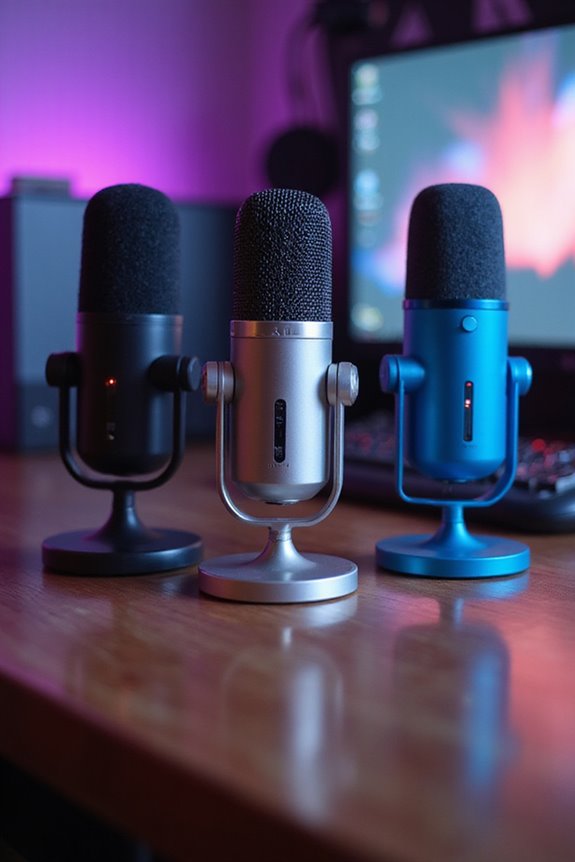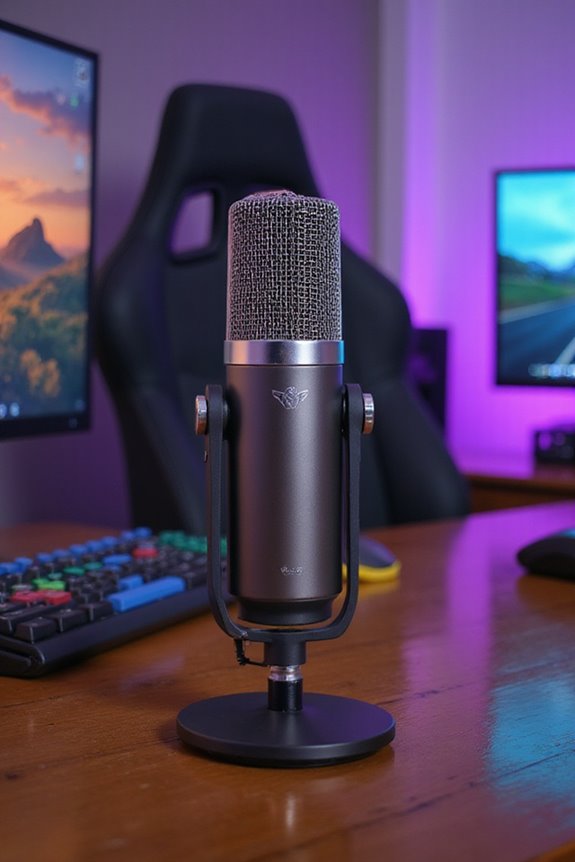As an Amazon Associate, we earn from qualifying purchases. Some links may be affiliate links at no extra cost to you. Although our opinions are based on curated research, we haven't used these products. Articles generated with AI.

3 Best Streaming Microphones for PC in 2025 – Crystal Clear Audio for Gamers and Creators
If you’re looking for the best streaming microphones for PC in 2025, consider the EJoy D10 PRO for its wireless convenience and cardioid polar pattern. The FIFINE T669 kit is great with its included accessories, but the boom arm could be sturdier. Finally, the Logitech Blue Yeti offers versatile pickup patterns and impressive sound quality, although its size may hinder portability. Each has strengths and weaknesses, making the choice yours, so stick around for more insights on optimizing your setup!
Key Takeaways
- The EJoy D10 PRO offers wireless flexibility and excellent audio quality with a cardioid pattern, ideal for gamers and streamers.
- FIFINE T669 includes essential accessories, providing a great value setup for clear audio capture in various environments.
- Logitech Blue Yeti’s multiple pickup patterns and onboard controls make it versatile for different recording scenarios, enhancing overall audio clarity.
- Look for microphones with a frequency response between 20Hz and 20kHz and high SNR for optimal sound quality.
- Prioritize portability, ergonomics, and design to ensure a comfortable and efficient streaming experience.
EJoy D10 PRO Wireless USB Gaming Microphone
EJoy D10 PRO(D) Wireless USB Gaming Microphone – RGB Dynamic Mic with Wired/Wireless Modes,...
- Wired & Wireless Flexibility:Comica EJoy D10 PRO is a professional studio microphone that supports wired/wireless dual modes and can switch seamlessly between wired and...
- Cardioid Dynamic Mic:Comica EJoy D10 PRO streaming microphone adopts a cardioid polar pattern design to clearly capture the sound source directly in front of it. This...
- Digital/Analog Dual Output:Equipped with XLR professional interface and USB-C digital interface, EJoy D10 PRO is widely compatible with sound cards, recorders, mixers,...
If you’re looking for a versatile microphone that suits both gaming and streaming, the EJoy D10 PRO Wireless USB Gaming Microphone might just be your best bet. With its dual modes, you can switch seamlessly between wired and wireless, boasting a stable transmission range of 40 meters. The cardioid polar pattern captures direct sound, while the large-diaphragm head offers impressive noise immunity.
You’ll appreciate the 48kHz/24bit recording for lossless quality. Plus, the four adjustable mic gain levels and one-click mute function provide control over your sound. However, some users have mentioned the manual’s limited language options. Still, it’s a solid choice for creators.
Best For: The EJoy D10 PRO Wireless USB Gaming Microphone is best for gamers, streamers, and podcasters looking for high-quality sound and versatile usage options.
Pros:
- Supports both wired and wireless modes with a stable transmission range of up to 40 meters.
- Impressive sound quality with 48kHz/24bit recording and noise immunity.
- Customizable features including adjustable mic gain levels and RGB lighting effects enhance the user experience.
Cons:
- Manual available only in English and Chinese, limiting accessibility for non-speakers.
- Volume dial markings may lack clarity, leading to potential user confusion.
- Lightweight design may not suit everyone for long-term use comfort.
FIFINE Studio Condenser USB Microphone Kit (T669)
Sale
FIFINE Studio Condenser USB Microphone Computer PC Microphone Kit with Adjustable Boom Arm Stand...
- [USB Output] Enables simple setup. USB studio recording microphone kit provides a direct convenient plug-and-play connection to pc and laptop without any additional...
- [Excellent Sound Quality] With rugged construction for durable performance, the vocal recording microphone, USB condenser mic for PC,offers a wide frequency response and...
- [Durable Arm Set] The podcast microphone bundle with versatile and sturdy broadcast suspension boom scissor arm with 180° up and down rotation, 135° forward and...
The FIFINE Studio Condenser USB Microphone Kit (T669) is a standout option for aspiring podcasters, gamers, and content creators seeking to elevate their audio quality without breaking the bank. With its cardioid condenser capsule, it captures clear audio while minimizing background noise, making it perfect for voiceovers and streaming. The kit includes a boom arm, shock mount, and double pop filter, ensuring stability and reducing unwanted vibrations during recordings.
Setup is a breeze thanks to its plug-and-play USB connection, while compatibility with popular software like OBS and Audacity makes it user-friendly. Just keep in mind that it may pick up noise in uncontrolled environments.
Best For: Aspiring podcasters, gamers, and content creators looking to enhance their audio quality at an affordable price.
Pros:
- Clear audio quality with minimal background noise due to the cardioid condenser capsule.
- Comprehensive kit includes essential accessories like a boom arm, shock mount, and double pop filter.
- Easy setup with plug-and-play USB connection and compatibility with popular recording software.
Cons:
- May pick up background noise in uncontrolled environments.
- Some users find the boom arm to be flimsy and suggest alternative mounting methods.
- Stand articulation could be improved for better adjustment flexibility.
Logitech Blue Yeti USB Microphone for Gaming and Streaming
Logitech for Creators Blue Microphones Yeti USB Microphone (Blackout)
- Ergonomics: Yeti features studio controls for headphone volume, pattern selection, instant mute, and microphone gain putting you in charge of every level of the recording...
- Application: Ideal for for vocals, musical instruments, podcasting, voice overs, interviews, gaming, field recordings, conference calls and more
- Smooth Operation: Comes equipped with a 3.5-millimeter headphone jack that allows you to listen to what you're recording in real-time, without latency delays which means...
Looking for a microphone that delivers professional-grade sound without overwhelming complexity? The Logitech Blue Yeti USB Microphone is a fantastic choice for gaming, streaming, and podcasting. Its custom three-capsule array guarantees powerful, broadcast-quality audio, while four versatile pickup patterns let you adapt to any recording scenario.
With onboard audio controls, you can easily adjust headphone volume and mic gain. Plus, the Blue VOICE software enhances your recordings with advanced vocal effects. Just keep in mind that it can be sensitive to vibrations, so careful positioning is key. Overall, it’s a solid option for creators at any level.
Best For: The Logitech Blue Yeti USB Microphone is best for gamers, streamers, and podcasters seeking high-quality audio without complicated setup.
Pros:
- Versatile pickup patterns allow for various recording scenarios, making it suitable for different types of content.
- Onboard audio controls enable easy adjustments for headphone volume and microphone gain, enhancing user convenience.
- High average rating from users highlights its exceptional audio quality and reliability for both casual and professional use.
Cons:
- Sensitivity to vibrations may require careful positioning to avoid unwanted noise during recordings.
- Full functionality requires Logitech G HUB, which adds an additional software dependency for users.
- Weight and size may not be ideal for portable setups, limiting its use for on-the-go content creators.
Factors to Consider When Choosing a Streaming Microphone for PC

When you’re choosing a streaming microphone for your PC, sound quality should be at the top of your list. You’ll also want to contemplate the connectivity options available, like USB or XLR, as well as the type of microphone that best fits your needs. Don’t forget to evaluate your budget, portability, and design, too—these factors can really impact your streaming experience.
Sound Quality Importance
Sound quality plays a pivotal role in the streaming experience, as it directly affects how well your audience can engage with your content. A microphone’s frequency response, ideally between 20Hz and 20kHz, captures a wide range of sounds, enhancing audio clarity. You’ll want a high signal-to-noise ratio (SNR), like 78 dB, to minimize background noise and guarantee your voice comes through clearly. Choosing a cardioid polar pattern is essential; it focuses on sound directly in front of the mic, reducing unwanted ambient noise. Plus, real-time monitoring lets you adjust sound levels on the fly, helping you maintain excellent audio quality. Investing in a quality mic means your audience won’t miss a word, making your streams much more engaging.
Connectivity Options Available
After establishing sound quality as a key element for engaging streams, it’s time to explore the connectivity options available in streaming microphones. Most microphones offer USB connectivity, making them easy to plug and play with your PC or laptop—no extra drivers needed. Some models feature both USB and XLR connections, giving you versatility for different setups and the chance to connect to professional audio gear. If you prefer mobility, wireless options can provide stable transmission ranges of up to 40 meters. Plus, look for real-time monitoring through a 3.5mm headphone jack, so you can hear your audio while streaming. Just remember to check compatibility with your software and devices, as some may require additional setups for full functionality.
Microphone Type Selection
Choosing the right microphone type can make a significant difference in your streaming experience, especially if you want to guarantee your voice comes through clearly and professionally. Condenser microphones are great for capturing vocals but can be sensitive to background noise, while dynamic microphones are perfect for handling loud sounds and are more durable.
When selecting a microphone, consider the polar pattern; cardioid is popular for streaming because it focuses on sound directly in front, minimizing distractions. Look for a microphone with a wide frequency response, ideally 20Hz to 20kHz, to capture every nuance of your voice. Built-in features like gain control and headphone monitoring can enhance your streaming sessions, giving you more control over your audio.
Budget Considerations
Budgeting for a streaming microphone can feel overwhelming, but it’s a key part of your setup. Entry-level models typically range from $50 to $100, while mid-range and high-end options can exceed $200. Keep in mind the extra costs for accessories like boom arms and pop filters, which can enhance your audio quality.
Think about the microphone’s long-term value; a more durable model may save you money in the long run. Don’t forget to research customer ratings—these insights can reveal if budget-friendly options meet performance expectations. Also, factor in any additional software or equipment you might need, as these can add unexpected expenses. Balancing quality with cost will help you make a smart investment for your streaming journey.
Portability and Design
When selecting a streaming microphone, you’ll want to contemplate portability and design, especially if you plan to move your setup frequently. Lightweight microphones can make transportation a breeze, giving you the flexibility to set up wherever you like. A compact design seamlessly fits into different workspaces, helping keep things organized and tidy.
Look for adjustable features like boom arms or flexible stands; they improve ergonomics and allow for ideal microphone positioning without crowding your desk. Durability is key too, as a robust construction can survive travel and frequent adjustments. Finally, consider aesthetics—color and lighting options can enhance your streaming space, making it visually appealing during your live sessions.
Additional Features Needed
A quality streaming microphone can make all the difference in your audio experience, and considering additional features is essential. Look for microphones offering multiple pickup patterns—cardioid, omni, bidirectional, and stereo—to capture various audio sources effectively. Onboard audio controls like headphone volume, pattern selection, and instant mute give you greater control during streaming sessions.
Ensure the microphone boasts high-quality specifications, with a frequency response of at least 20Hz to 20kHz and a signal-to-noise ratio above 75 dB for clarity. Real-time monitoring features, such as a 3.5mm headphone jack, help you hear your voice while adjusting levels. Finally, additional perks like RGB lighting and EQ settings can add flair and professionalism to your setup without overwhelming you.
Frequently Asked Questions
What Is the Ideal Distance From the Microphone for Optimal Sound Quality?
To get the best sound quality, you should position yourself about 6 to 12 inches from the microphone. This distance allows your voice to be clear while minimizing background noise. If you’re too close, you might encounter plosives or distortion. On the flip side, being too far can make your voice sound weak. Experiment within this range to find what works best for your setup, and enjoy the improved audio clarity!
Can I Use a Streaming Microphone With a Gaming Console?
Sure, you can connect a streaming microphone to a gaming console! Many modern microphones, like USB or XLR models, offer versatile connectivity options. Just check if your console supports USB mics, as that’s often the easiest way to plug in. Keep in mind, though, that some setups may require an audio interface or mixer for ideal sound. So, be ready for a little extra gear if your mic needs it!
Do I Need Additional Software for Microphone Setup?
You don’t always need additional software for microphone setup, but it can enhance your experience. Many USB microphones work right out of the box, allowing you to quickly plug and play. However, specialized software can access features like gain control, EQ settings, and noise reduction, which improve audio quality. Just keep in mind that some software may require a learning curve, but it’s worth it for better sound clarity in your streams!
How Can I Reduce Background Noise While Streaming?
You can reduce background noise while streaming by using a cardioid microphone. This type captures sound from the front while minimizing noise from the sides and rear. Additionally, consider using software like noise gates or audio filters, which can help eliminate unwanted sounds during your stream. Don’t forget to position your mic close to your mouth, as this boosts your voice while drowning out distractions. A bit of strategic setup goes a long way!
What Accessories Enhance Microphone Performance for Streaming?
You might think a good microphone’s all you need, but accessories can really enhance your streaming experience. A pop filter reduces plosive sounds, while a shock mount minimizes vibrations and handling noise. Investing in a boom arm lets you position your mic perfectly, keeping it out of the way. Don’t forget an audio interface for better sound quality; it offers higher fidelity and more control over your audio levels. Happy streaming!







